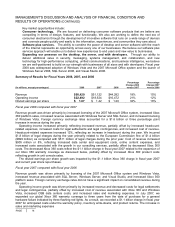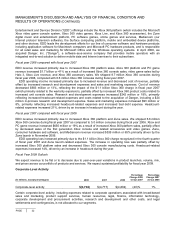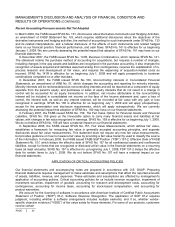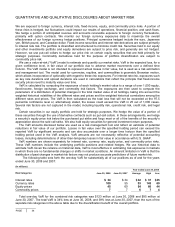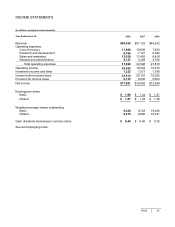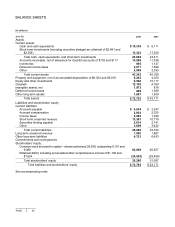Microsoft 2008 Annual Report Download - page 27
Download and view the complete annual report
Please find page 27 of the 2008 Microsoft annual report below. You can navigate through the pages in the report by either clicking on the pages listed below, or by using the keyword search tool below to find specific information within the annual report.
PAGE 26
MANAGEMENT’S DISCUSSION AND ANALYSIS OF FINANCIAL CONDITION AND
RESULTS OF OPERATIONS (CONTINUED)
Income Taxes
Our effective tax rates for fiscal years 2008, 2007, and 2006 were 26%, 30%, and 31%, respectively. Our effective
tax rates are less than the statutory tax rate due to foreign earnings taxed at lower rates. The decreased rate in
fiscal year 2008 resulted from resolution of tax positions related to our settlement with the Internal Revenue
Service (“IRS”) for its 2000-2003 examination. This decline was partially offset by the tax effect of the European
Commission fine of $1.4 billion (€899 million), which was not tax deductible. The fiscal year 2007 rate reflects a
recurring effective tax rate of 31%, offset by a $195 million reduction resulting from various changes in tax
positions taken in prior periods, related primarily to favorable developments in an IRS position and multiple foreign
audit assessments. During fiscal year 2006, we recorded a tax benefit of $108 million from the resolution of state
audits and recorded a charge of $351 million (€ 281 million) from the European Commission fine which was not
tax deductible.
On July 1, 2007, we adopted the provisions of the Financial Accounting Standards Board (“FASB”)
Interpretation No. 48 (“FIN 48”) Accounting for Uncertainty in Income Taxes – an interpretation of FASB
Statement No. 109, which provides a financial statement recognition threshold and measurement attribute for a
tax position taken or expected to be taken in a tax return. Adopting FIN 48 had the following impact on our
financial statements: increased current assets by $228 million, long-term assets by $1.1 billion, long-term
liabilities by $2.1 billion, and our retained deficit by $395 million; and decreased our income taxes payable by
$394 million. As of June 30, 2008, we had $3.2 billion of unrecognized tax benefits of which $2.3 billion, if
recognized, would affect our effective tax rate. As of July 1, 2007, we had $7.1 billion of unrecognized tax benefits
of which $5.3 billion, if recognized, would affect our effective tax rate. Our policy is to include interest and
penalties related to unrecognized tax benefits in income tax expense. Interest totaled $121 million in fiscal year
2008. As of June 30, 2008 and July 1, 2007, we had accrued interest related to uncertain tax positions of $324
million and $863 million, respectively, net of federal income tax benefits, on our balance sheets.
Financial Condition
Cash, cash equivalents, and short-term investments totaled $23.7 billion and $23.4 billion as of June 30, 2008
and 2007, respectively. Equity and other investments were $6.6 billion and $10.1 billion as of June 30, 2008 and
2007, respectively. Our investments consist primarily of fixed-income securities, diversified among industries and
individual issuers. Our investments are generally liquid and investment grade. The portfolio is invested
predominantly in U.S.-dollar-denominated securities, but also includes foreign-denominated securities in order to
diversify financial risk. As a result of the special dividend paid in the second quarter of fiscal year 2005 and shares
repurchased, our retained deficit, including accumulated other comprehensive income, was $26.6 billion at
June 30, 2008. Our retained deficit is not expected to impact our future ability to operate or pay dividends given
our continuing profitability and strong cash and financial position.
In general, and where applicable, we use quoted prices in active markets for identical assets or liabilities to
price positions. This pricing methodology applies to exchange-traded mutual funds, domestic and international
equities, U.S. treasuries, and agency securities. If quoted prices in active markets for identical assets or liabilities
are not available to price positions, then we use inputs other than the quoted prices that are observable either
directly or indirectly. Assets and liabilities measured using unobservable inputs are an immaterial portion of our
portfolio.
While we own certain mortgage- and asset-backed fixed-income securities, our portfolio as of June 30, 2008
does not contain direct exposure to subprime mortgages or structured vehicles that derive their value from
subprime collateral. The majority of the mortgage-backed securities are collateralized by prime residential
mortgages and carry a 100% principal and interest guarantee, primarily from Federal National Mortgage
Association, Federal Home Loan Mortgage Corporation, and Government National Mortgage Association. The
remainder of the mortgage position is collateralized by high quality international prime residential mortgage loans.
Unearned Revenue
Unearned revenue is comprised of the following items:
Volume licensing programs – Represents customer billings for multi-year licensing arrangements, paid either
upfront or annually at the beginning of each billing coverage period, which are accounted for as subscriptions with
revenue recognized ratably over the billing coverage period.


